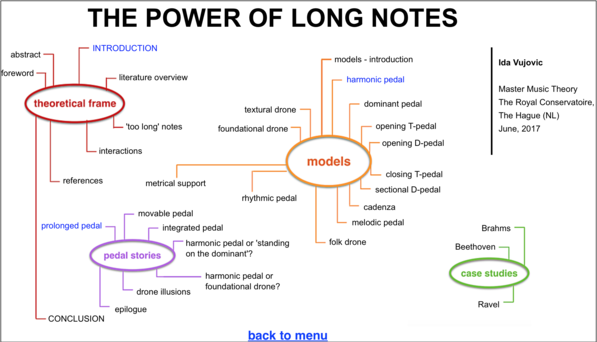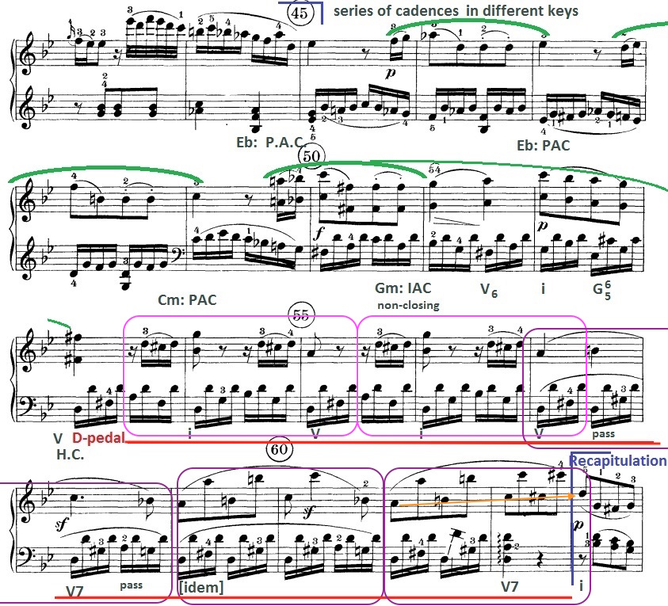Dominant Pedal In The Bass
The dominant pedal begins as the bass tone of an implicative dominant harmony: the harmony that incites expectation of the tonic chord, as its resolution. The actual transformation of the bass tone into the pedal happens at the moment when the splitting of the harmonic space takes place, and the sustained dominant pitch in the bass prevents the harmonic flow from the expected continuation. The resolution of the dominant is denied. The pedal opens with denial-tension. Its prolongation expands the phrase and the listener can experience expectation-tension, due to the anticipation of the resolution of this chord. As the appearance of the resolving chord is further delayed, the expectation-tension is growing.
Compared to the tonic pedal, dominant pedal is twice as ‘dissonant’: with the harmony, and with the key (the tonic is the only pitch that is perfectly consonant with the key; other pitches will at some point resolve in the tonic). The resolution of the dominant pedal is thus twofold, and in two consecutive steps: 1) the other harmonic layer must return to the dominant, 2) together they will resolve in the tonic. The expectation-tension is thus also double.
In the first movement of Mozart’s string quartet kv.421, the end of the development section is marked by a short dominant pedal:[1]
The dominant is reached one bar before the sustained tone in the Vcl part. The neighboring harmony Bb (VI) in m.68 is very dissonant to it, and the half tone relationship attracts Bb back to A (expected resolution of the progressing harmony into the pedal). The splitting of the harmonic space into the bass and the other voices is emphasized by the splitting of the textural space into the sustained sound versus the movement that is established in the previous bar (imitation of the two melodic motifs). The tension caused by this event is increased by the sharp dissonance (Bb) that appears suddenly, accented by the fp dynamics. The return of the dominant (now V7) is in this way made powerful, the dominant itself even stronger, the expectation-tension raised higher. Melodic actor, consisting of the long notes in the higher register (marked green in the image) is interacting cooperatively with the working of the pedal: after the melodic Bb has not returned to A, but instead has moved to C#, melodic D is highly expected, together with the tonic chord.
Another actor adds to the tension felt related to this pedal: it is the feeling for harmonic rhythm and proportions. After the falling-fifth sequence (2-bars model, preceding the fragment in the image), and two shorter units based on the same 1-bar motif (first bars in the image above), the cadential acceleration brings us to the dominant chord (just before the pedal). Although this could be analyzed as a H.C., and although this dominant is of most structural value, there is some feeling of restlessness in this chord. While being the target of cadential progression, it does not bring the peace of an arrival. The high dynamic energy of the dominant is the result of the combination of the harmonic, rhythmic and melodic actors. There is too much activity in m.66 to feel the closure. The 6/4 chord in m.66 is firmly resolved in m.67. The descending octave in the bass calms the harmonic progression and if the other voices were also calmed, the dynamic energy of the dominant chord would decrease. However, the ascending order of imitation in m.67 raises attention, and works as a preparation. The tonic is expected to come. In this situation, Bb chord in m.68 incites the denial-tension, the tonic is denied. According to Margulis (2006), the listener feels determination: the tonic is even more wanted.
The resolving tonic feels as a relief, a return to a more quiet, safe, home. Due to the attention that it attracts, it is often used at the end of modulative sections, to establish the new key. As such, this model is an effective element for preparing the return of the main theme, for example, in a rounded binary form or in the sonata-allegro form (such as in the previous example). The resolving tonic chord will be the first chord in the reprise.
The following example from the first movement of Beethoven’s piano sonata op.49, no.1 shows a longer D-pedal, also preparing the recapitulation. This pedal comes into existence through several phases, each slightly more exciting than the previous.
The development section of this movement emphasizes Eb major key. From m.47 on, the music gradually returns to the home-key, G minor, through a series of imitations of a cadential motif (marked green). The last imitation evades perfect authentic cadence, and leads to the stronger cadence, reinforced by the dominant pedal. The pedal tone is not sustained and appears in 3 variants: 1) first only on the first downbeat in each bar (the harmony above alternating V and i), 2) then on each beat in the bar (from m.51; the other voices are turning into melodic voices featuring passing tones between the tones of V7), and 3) the final strike (the upper melodic voice continues with another passing note in the same direction). Together with the bass pedal, another D-pedal is active in the middle register (such pedal will be discussed in the chapter ‘Pedal in the upper, accompanying voices’).
Compared to the first example (Mozart), this pedal has less power, despite its size. Why is this so? I believe it has to do with rounding off of the pedal-phases in Beethoven. In mm.53-54 (pink selection) the harmony goes to the neighboring chord and back (V-i-V), and the melody features ascending leap, than descending one. These two bars are repeated without intensification. The following phase, mm.57-58 (purple selection) is similar: the tension increases and then decreases, as both the harmony and the melody return to the first position. These two bars are also repeated, this time with small intensification: the melody is doubled in octave. The second time this motif is repeated (in m.61), there is more tension. The melodic line continues to move up (orange arrow in the image), and the rhythmic movement of the accompaniment stops. This event very directly marks the end of the previous material, and announces something else. In a way, this last bar (m.62) feels like a pedal more than all the previous bars with an explicit pedal. In this last phase of the D-pedal in this fragment, there is more splitting (the bass stops, the melody continues), more conflict (also accented dissonance), more pedal-ness. Compared to this last moment, and also to the pedal from Mozart’s fragment, the most part of the long D-pedal in Beethoven’s piece could also be seen as ‘just’ a long standing on the dominant.
The power of dominant pedal is in the denial-tension and the two-fold expectation-tension that it incites. The stronger expectation of the tonic resolution - the stronger harmonic effect of the pedal: the stronger its pedal-ness. When harmonic layer above the pedal progresses in such way that the key becomes instable, the harmonic identity of the pedal also becomes instable. If the dominant-ness of the pedal decreases, so does also its implicativeness. The expectation-tension decreases and so does the power of the pedal (as harmonic pedal). In music of Brahms there are many examples of dominant pedal with variable harmonic strength. One of them is discussed in Pedal Story: ‘Integrated pedals’.
Brahms example shows a too-extensive conflict in the harmonic realm that jeopardizes the pedal-ness of the harmonic pedal. On the other end of the same line is the situation where a pedal might not be labeled as such because of too little conflict in the harmonic realm. Pedal Story ‘Harmonic pedal or standing on the dominant’ discusses one such situation, related to a fragment from Bruckner’s 7th symphony. It features a very long dominant pedal, that is, in its most exciting part actually consonant with the harmony above it.


